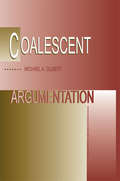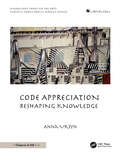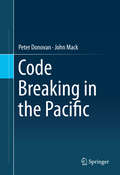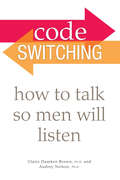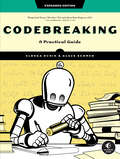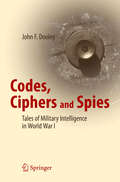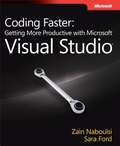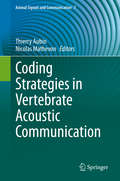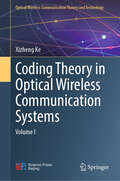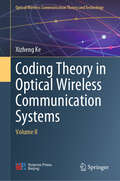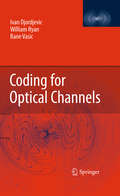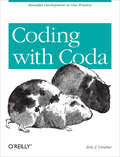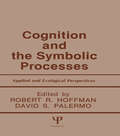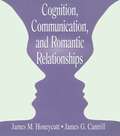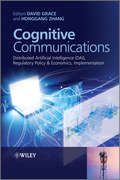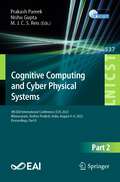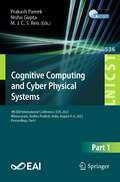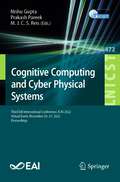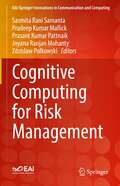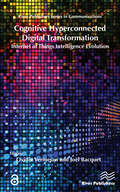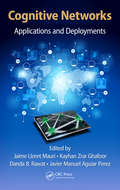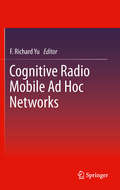- Table View
- List View
Coalescent Argumentation
by Michael A. GilbertCoalescent Argumentation is based on the concept that arguments can function from agreement, rather than disagreement. To prove this idea, Gilbert first discusses how several components--emotional, visceral (physical) and kisceral (intuitive) are utilized in an argumentative setting by people everyday. These components, also characterized as "modes," are vital to argumentative communication because they affect both the argument and the resulting outcome. In addition to the components/modes, this book also stresses the goals in argumentation as a means for understanding one's own and one's opposer's positions. Gilbert argues that by viewing positions as complex human events involving a variety of communicative modes, we are better able to find commonalities across positions, and, therefore, move from conflict to resolution. By focusing on agreement and shared goals in all modes, arguers can coalesce diverse positions and more easily distinguish between minor or unrelated differences and core disagreements. This permits much greater latitude for locating shared beliefs, values, and attitudes that will lead to conflict resolution.
Code Appreciation: Reshaping Knowledge
by Anna UrsynLike art appreciation and music appreciation, this code appreciation book invites the readers to look relaxedly into major programming concepts used in many disciplines through short stories set in alphabetical order. Some students fear technology with programming behind it, and shy away from the word "coding." Coding has become common and needed, and these stories are set to help non-coders lose their inhibition. It also might help with prompt writing. Many employers seek employees with experience in visual communication, technology, and storytelling skills. Most tasks are created through group efforts, so a better grasp of what other co-workers are doing speeds up the process.The book offers a new approach to storytelling by weaving coding into stories. Playfully, it encourages the readers to see computing as easier to understand and present in most disciplines. The book might benefit high school and middle school students, faculty, advisors, chancellors, and those seeking majors or passions. People interested in computer graphics, arts, graphic design, computer science, and others may gain a general understanding of how technology affects various disciplines and how everything is connected.This book is a part of the “Knowledge Through the Arts” series, consisting of:Dance Code — Dance Steps as a CodeNew Storytelling — Learning Through MetaphorsCode Appreciation — Reshaping KnowledgeNature Appreciation — Knowledge as Art
Code Breaking in the Pacific
by Peter Donovan John MackThis book reveals the historical context and the evolution of the technically complex Allied Signals Intelligence (Sigint) activity against Japan from 1920 to 1945. It traces the all-important genesis and development of the cryptanalytic techniques used to break the main Japanese Navy code (JN-25) and the Japanese Army's Water Transport Code during WWII. This is the first book to describe, explain and analyze the code breaking techniques developed and used to provide this intelligence, thus closing the sole remaining gap in the published accounts of the Pacific War. The authors also explore the organization of cryptographic teams and issues of security, censorship, and leaks. Correcting gaps in previous research, this book illustrates how Sigint remained crucial to Allied planning throughout the war. It helped direct the advance to the Philippines from New Guinea, the sea battles and the submarine onslaught on merchant shipping. Written by well-known authorities on the history of cryptography and mathematics, Code Breaking in the Pacific is designed for cryptologists, mathematicians and researchers working in communications security. Advanced-level students interested in cryptology, the history of the Pacific War, mathematics or the history of computing will also find this book a valuable resource.
Code Switching: How to Talk So Men Will Listen
by Audrey Nelson Claire Damken BrownMars and Venus head to work... Day-to-day, face-to-face workplace communication between men and women is often dysfunctional because each gender employs different speech patterns. When careers and paychecks are on the line, clear communication is crucial-from the mailroom to the boardroom. Code Switching explains what to say, how to say it, how to be taken seriously, and how to act while speaking with the opposite sex for maximum effectiveness in the workplace. Included are: How men and women manage conversation, and the value of "chitchat" prior to a meeting. How men use language to impart information and women use language to build or indicate relationship. How men use e-mail to emphasize control while women use it to share and build rapport. How women can use language to build their credibility. How humor is used as a power play, to build territory, or to exclude others. How gender talk creates and shapes work relationships.
Codebreaking: A Practical Guide
by Klaus Schmeh Elonka DuninIf you liked Dan Brown&’s Da Vinci Code—or want to solve similarly baffling cyphers yourself—this is the book for you! A thrilling exploration of history&’s most vexing codes and ciphers that uses hands-on exercises to teach you the most popular historical encryption schemes and techniques for breaking them.Solve history&’s most hidden secrets alongside expert codebreakers Elonka Dunin and Klaus Schmeh, as they guide you through the world of encrypted texts. With a focus on cracking real-world document encryptions—including some crime-based coded mysteries that remain unsolved—you&’ll be introduced to the free computer software that professional cryptographers use, helping you build your skills with state-of-the art tools. You&’ll also be inspired by thrilling success stories, like how the first three parts of Kryptos were broken. Each chapter introduces you to a specific cryptanalysis technique, and presents factual examples of text encrypted using that scheme—from modern postcards to 19-century newspaper ads, war-time telegrams, notes smuggled into prisons, and even entire books written in code. Along the way, you&’ll work on NSA-developed challenges, detect and break a Caesar cipher, crack an encrypted journal from the movie The Prestige, and much more.You&’ll learn: How to crack simple substitution, polyalphabetic, and transposition ciphers How to use free online cryptanalysis software, like CrypTool 2, to aid your analysisHow to identify clues and patterns to figure out what encryption scheme is being usedHow to encrypt your own emails and secret messagesCodebreaking is the most up-to-date resource on cryptanalysis published since World War II—essential for modern forensic codebreakers, and designed to help amateurs unlock some of history&’s greatest mysteries.
Codes, Ciphers and Spies: Tales of Military Intelligence in World War I
by John F. DooleyWhen the United States declared war on Germany in April 1917, it was woefully unprepared to wage a modern war. Whereas their European counterparts already had three years of experience in using code and cipher systems in the war, American cryptologists had to help in the building of a military intelligence unit from scratch. This book relates the personal experiences of one such character, providing a uniquely American perspective on the Great War. It is a story of spies, coded letters, plots to blow up ships and munitions plants, secret inks, arms smuggling, treason, and desperate battlefield messages. Yet it all begins with a college English professor and Chaucer scholar named John Mathews Manly. In 1927, John Manly wrote a series of articles on his service in the Code and Cipher Section (MI-8) of the U. S. Army's Military Intelligence Division (MID) during World War I. Published here for the first time, enhanced with references and annotations for additional context, these articles form the basis of an exciting exploration of American military intelligence and counter-espionage in 1917-1918. Illustrating the thoughts of prisoners of war, draftees, German spies, and ordinary Americans with secrets to hide, the messages deciphered by Manly provide a fascinating insight into the state of mind of a nation at war.
Coding Faster: Getting More Productive with Microsoft® Visual Studio®
by Sara Ford Zain NaboulsiExpert advice to help you work smarter and increase your productivity with Visual Studio. Take a detailed look into Visual Studio--and learn practical techniques to help you work more efficiently. This fully revised and expanded version of Visual Studio Tips: 251 Ways to Improve Your Productivity includes a comprehensive collection of tips and shortcuts for working with the code editor, visual designers, searches, debugger, and other features in Visual Studio 2005, 2008, and 2010. You'll gain valuable insights for using this IDE--no matter what your experience level. Discover how to: Change development settings and keyboard mappings to optimize your efficiency Save time initiating a new project by creating custom templates Uncover secrets for working with the toolbox, commands, and window layouts Work with files in more practical ways, such as using the File Tab Channel Use the Editor more effectively with tips on selecting and manipulating code Apply techniques to help reduce the time you spend debugging code Create Visual Studio extensions to increase your development productivity
Coding Literacy: How Computer Programming Is Changing Writing (Software Studies)
by Annette VeeHow the theoretical tools of literacy help us understand programming in its historical, social and conceptual contexts.The message from educators, the tech community, and even politicians is clear: everyone should learn to code. To emphasize the universality and importance of computer programming, promoters of coding for everyone often invoke the concept of “literacy,” drawing parallels between reading and writing code and reading and writing text. In this book, Annette Vee examines the coding-as-literacy analogy and argues that it can be an apt rhetorical frame. The theoretical tools of literacy help us understand programming beyond a technical level, and in its historical, social, and conceptual contexts. Viewing programming from the perspective of literacy and literacy from the perspective of programming, she argues, shifts our understandings of both. Computer programming becomes part of an array of communication skills important in everyday life, and literacy, augmented by programming, becomes more capacious.Vee examines the ways that programming is linked with literacy in coding literacy campaigns, considering the ideologies that accompany this coupling, and she looks at how both writing and programming encode and distribute information. She explores historical parallels between writing and programming, using the evolution of mass textual literacy to shed light on the trajectory of code from military and government infrastructure to large-scale businesses to personal use. Writing and coding were institutionalized, domesticated, and then established as a basis for literacy. Just as societies demonstrated a “literate mentality” regardless of the literate status of individuals, Vee argues, a “computational mentality” is now emerging even though coding is still a specialized skill.
Coding Strategies in Vertebrate Acoustic Communication (Animal Signals and Communication #7)
by Thierry Aubin Nicolas MathevonInformation is a core concept in animal communication: individuals routinely produce, acquire, process and store information, which provides the basis for their social life. This book focuses on how animal acoustic signals code information and how this coding can be shaped by various environmental and social constraints. Taking birds and mammals, including humans, as models, the authors explore such topics as communication strategies for “public” and “private” signaling, static and dynamic signaling, the diversity of coded information and the way information is decoded by the receiver. The book appeals to a wide audience, ranging from bioacousticians, ethologists and ecologists to evolutionary biologists. Intended for students and researchers alike, it promotes the idea that Shannon and Weaver’s Mathematical Theory of Communication still represents a strong framework for understanding all aspects of the communication process, including its dynamic dimensions.
Coding Theory in Optical Wireless Communication Systems: Volume I (Optical Wireless Communication Theory and Technology)
by Xizheng KeThis book focuses on optical-wireless communication systems. It summarizes the author's optical-wireless communication coding work while carrying out pertinent scientific research programs. The primary topics covered in the book are channel coding, coding modulation, error control (channel coding), and channel equalization. The author's mathematical analysis and experimental studies on the key theoretical issues are discussed in the book. One of the book's outstanding aspects is its thorough and methodical discussion of practical optical-wireless communication challenges. This makes the book especially appealing to readers who are eager to learn about applicable solutions in this area. Researchers, engineers, and graduate students in the subject of telecommunications can all profit from the book. It is appropriate for senior undergraduates, lecturers at colleges and universities, graduate students, and engineering and technical workers involved in optical communication.
Coding Theory in Optical Wireless Communication Systems: Volume II (Optical Wireless Communication Theory and Technology)
by Xizheng KeThis book focuses on optical-wireless communication systems. It summarizes the author's optical-wireless communication coding work while carrying out pertinent scientific research programs. The primary topics covered in the book are channel coding, coding modulation, error control (channel coding), and channel equalization. The author's mathematical analysis and experimental studies on the key theoretical issues are discussed in the book. One of the book's outstanding aspects is its thorough and methodical discussion of practical optical-wireless communication challenges. This makes the book especially appealing to readers who are eager to learn about applicable solutions in this area. Researchers, engineers, and graduate students in the subject of telecommunications can all profit from the book. It is appropriate for senior undergraduates, lecturers at colleges and universities, graduate students, and engineering and technical workers involved in optical communication.
Coding for Optical Channels
by William Ryan Ivan Djordjevic Bane VasicIn order to adapt to the ever-increasing demands of telecommunication needs, today's network operators are implementing 100 Gb/s per dense wavelength division multiplexing (DWDM) channel transmission. At those data rates, the performance of fiberoptic communication systems is degraded significantly due to intra- and inter-channel fiber nonlinearities, polarization-mode dispersion (PMD), and chromatic dispersion. In order to deal with those channel impairments, novel advanced techniques in modulation and detection, coding and signal processing are needed. This unique book represents a coherent and comprehensive introduction to the fundamentals of optical communications, signal processing and coding for optical channels. It is the first to integrate the fundamentals of coding theory with the fundamentals of optical communication.
Coding with Coda: Beautiful Development in One Window
by Eric J GruberLike to build websites in the wild with your MacBook? This concise hands-on guide introduces you to the ideal editor: Coda 2. Rather than clutter your screen with shell access, a separate CSS editor, and a version control app, you’ll discover how Coda’s "one-window web development" bundles everything into one neat application. Take Coda on a trial run, then learn step-by-step how to configure each feature to fit your working style. You’ll find out firsthand how Coda will save you time and effort on your next project.Get to know Coda’s workflow by building a sample siteDelve into features such as the tab bar, path bar, sidebar, and Sites viewSet up your own development environment—and dig deeper into the editor’s optionsGet tips for taking full advantage of the text and MySQL editorsCreate a Git or Subversion repository for source control managementLearn the finer points of sharing project documents across a networkDiscover the built-in reference books, and learn how to extend Coda
Cognition and the Symbolic Processes: Applied and Ecological Perspectives
by Robert R. Hoffman David S. PalermoThis volume is a festschrift dedicated to James J. Jenkins, a pioneer in many areas of experimental psychology. It has three major goals: to provide a forum for debate on current theoretical issues in cognitive psychology, to capture the "state of the art" in reviews of research methods and results, and to generate ideas for new research directions and methodologies. Contributors -- including Jenkins' former students and present colleagues -- ponder fundamental questions such as: * How do people learn to read? * What happens during the processes of speech perception? * How do people acquire problem solving skills? * How do cognitive and motor skills develop and integrate with one another? Many chapters focus specifically on ecological and applied cognitive psychology. Specific topics covered include visual and speech perception, language, memory, motivation, child development, problem solving, and pedagogy.
Cognition, Communication, and Romantic Relationships (LEA's Series on Personal Relationships)
by James M. Honeycutt James G. CantrillCognition, Communication, and Romantic Relationships focuses on the role of memory, communication, and social cognition in the development of romantic relationships. The authors review developmental models of communication and examine criticisms of these models. They also explore the stages through which relationships escalate and deteriorate, and consider the processes for such activities as meeting new people, dating, sexual intercourse, and terminating relationships. Differences between men and women are discussed throughout the text, in light of current research supporting systematic gender differences in how people think about romance and relationships. As an extended analysis and research review of how thinking about romance influences and is influenced by communicative processes, this text offers a deeper understanding of the cognitive and communicative factors involved in relationship processes. It is designed for use in courses on interpersonal relationships and intimate relations in social psychology, communication, counseling psychology, clinical psychology, and sociology.
Cognitive Communications
by Honggang Zhang David GraceThis book discusses in-depth the concept of distributed artificial intelligence (DAI) and its application to cognitive communicationsIn this book, the authors present an overview of cognitive communications, encompassing both cognitive radio and cognitive networks, and also other application areas such as cognitive acoustics. The book also explains the specific rationale for the integration of different forms of distributed artificial intelligence into cognitive communications, something which is often neglected in many forms of technical contributions available today. Furthermore, the chapters are divided into four disciplines: wireless communications, distributed artificial intelligence, regulatory policy and economics and implementation. The book contains contributions from leading experts (academia and industry) in the field.Key Features:Covers the broader field of cognitive communications as a whole, addressing application to communication systems in general (e.g. cognitive acoustics and Distributed Artificial Intelligence (DAI)Illustrates how different DAI based techniques can be used to self-organise the radio spectrumExplores the regulatory, policy and economic issues of cognitive communications in the context of secondary spectrum accessDiscusses application and implementation of cognitive communications techniques in different application areas (e.g. Cognitive Femtocell Networks (CFN)Written by experts in the field from both academia and industryCognitive Communications will be an invaluable guide for research community (PhD students, researchers) in the areas of wireless communications, and development engineers involved in the design and development of mobile, portable and fixed wireless systems., wireless network design engineer. Undergraduate and postgraduate students on elective courses in electronic engineering or computer science, and the research and engineering community will also find this book of interest.
Cognitive Computing and Cyber Physical Systems: 4th EAI International Conference, IC4S 2023, Bhimavaram, Andhra Pradesh, India, August 4-6, 2023, Proceedings, Part II (Lecture Notes of the Institute for Computer Sciences, Social Informatics and Telecommunications Engineering #537)
by Nishu Gupta Prakash Pareek M. J. C. S. ReisThis 2-volume set constitutes the post-conference proceedings of the 4th International Conference on Cognitive Computing and Cyber Physical Systems, IC4S 2023, held in Bhimavaram, Andhra Pradesh, India, during August 4-6, 2023. The theme of IC4S 2023 was: cognitive approaches with machine learning and advanced communications. The 70 full papers were carefully reviewed and selected from 165 submissions. The papers are clustered in thematical issues as follows: machine learning and its applications; cyber security and signal processing; image processing; smart power systems; smart city eco-system and communications.
Cognitive Computing and Cyber Physical Systems: 4th EAI International Conference, IC4S 2023, Bhimavaram, Andhra Pradesh, India, August 4-6, 2023, Proceedings, Part I (Lecture Notes of the Institute for Computer Sciences, Social Informatics and Telecommunications Engineering #536)
by Nishu Gupta Prakash Pareek M. J. C. S. ReisThis 2-volume set constitutes the post-conference proceedings of the 4th EAI International Conference on Cognitive Computing and Cyber Physical Systems, IC4S 2023, Bhimavaram, Andhra Pradesh, India, during August 4-6, 2023. The theme of IC4S 2023 was: cognitive approaches with machine learning and advanced communications. The 70 full papers were carefully reviewed and selected from 165 submissions. The papers are clustered in thematical issues as follows: machine learning and its applications; cyber security and signal processing; image processing; smart power systems; smart city eco-system and communications.
Cognitive Computing and Cyber Physical Systems: Third EAI International Conference, IC4S 2022, Virtual Event, November 26-27, 2022, Proceedings (Lecture Notes of the Institute for Computer Sciences, Social Informatics and Telecommunications Engineering #472)
by Nishu Gupta Prakash Pareek M. J. C. S. ReisThis proceedings constitutes the post-conference proceedings of the 3rd EAI International Conference on Cognitive Computing and Cyber Physical Systems, IC4S 2022, held at Vishnu Institute of Technology, Bhimavaram in Andhra Pradesh, India, in November 26-27, 2022. The theme of IC4S 2022 was: cognitive computing approaches with data mining and machine learning techniques. The 22 full papers were carefully reviewed and selected from 88 submissions. The papers are clustered in thematical issues as follows: machine learning and its applications; cyber security and networking; image processing; IoT applications; smart city eco-system and communications.
Cognitive Computing for Risk Management (EAI/Springer Innovations in Communication and Computing)
by Prasant Kumar Pattnaik Pradeep Kumar Mallick Zdzislaw Polkowski Sasmita Rani Samanta Jnyana Ranjan MohantyThis book presents applications of cognitive management and cognitive computing in the fields of risk management, cognitive fraud detection, and in business decision making. The book provides insights on how cognitive management and cognitive computing enable businesses to quickly augment human intelligence and help humans perform tasks better. For example, the authors describe how by analyzing patterns in big data, small data, and "dark data," cognitive technologies can detect human behavior and suggest options for personalizing of products and services. The book studies companies in industries such as automotive, airline, health care, retail, wealth management, and litigation who have adopted these approaches.Presents applications of cognitive computing and cognitive management used in augmenting and empowering business decisions;Shows how to employ the Internet of Things in businesses using a cognitive management framework;Discusses technical aspects and alternatives to traditional tools, algorithms, and methodologies in cognitive computing.
Cognitive Hyperconnected Digital Transformation: Internet of Things Intelligence Evolution
by Ovidiu Vermesan Joël BacquetCognitive Hyperconnected Digital Transformation provides an overview of the current Internet of Things (IoT) landscape, ranging from research, innovation and development priorities to enabling technologies in a global context. It is intended as a standalone book in a series that covers the Internet of Things activities of the IERC-Internet of Things European Research Cluster, including both research and technological innovation, validation and deployment. The book builds on the ideas put forward by the European Research Cluster, the IoT European Platform Initiative (IoT-EPI) and the IoT European Large-Scale Pilots Programme, presenting global views and state-of-the-art results regarding the challenges facing IoT research, innovation, development and deployment in the next years. Hyperconnected environments integrating industrial/business/consumer IoT technologies and applications require new IoT open systems architectures integrated with network architecture (a knowledge-centric network for IoT), IoT system design and open, horizontal and interoperable platforms managing things that are digital, automated and connected and that function in real-time with remote access and control based on Internet-enabled tools. The IoT is bridging the physical world with the virtual world by combining augmented reality (AR), virtual reality (VR), machine learning and artificial intelligence (AI) to support the physical-digital integrations in the Internet of mobile things based on sensors/actuators, communication, analytics technologies, cyber-physical systems, software, cognitive systems and IoT platforms with multiple functionalities. These IoT systems have the potential to understand, learn, predict, adapt and operate autonomously. They can change future behaviour, while the combination of extensive parallel processing power, advanced algorithms and data sets feed the cognitive algorithms that allow the IoT systems to develop new services and propose new solutions. IoT technologies are moving into the industrial space and enhancing traditional industrial platforms with solutions that break free of device-, operating system- and protocol-dependency. Secure edge computing solutions replace local networks, web services replace software, and devices with networked programmable logic controllers (NPLCs) based on Internet protocols replace devices that use proprietary protocols. Information captured by edge devices on the factory floor is secure and accessible from any location in real time, opening the communication gateway both vertically (connecting machines across the factory and enabling the instant availability of data to stakeholders within operational silos) and horizontally (with one framework for the entire supply chain, across departments, business units, global factory locations and other markets). End-to-end security and privacy solutions in IoT space require agile, context-aware and scalable components with mechanisms that are both fluid and adaptive. The convergence of IT (information technology) and OT (operational technology) makes security and privacy by default a new important element where security is addressed at the architecture level, across applications and domains, using multi-layered distributed security measures. Blockchain is transforming industry operating models by adding trust to untrusted environments, providing distributed security mechanisms and transparent access to the information in the chain. Digital technology platforms are evolving, with IoT platforms integrating complex information systems, customer experience, analytics and intelligence to enable new capabilities and business models for digital business.
Cognitive Networked Sensing and Big Data
by Michael Wicks Robert QiuWireless Distributed Computing and Cognitive Sensing defines high-dimensional data processing in the context of wireless distributed computing and cognitive sensing. This book presents the challenges that are unique to this area such as synchronization caused by the high mobility of the nodes. The author will discuss the integration of software defined radio implementation and testbed development. The book will also bridge new research results and contextual reviews. Also the author provides an examination of large cognitive radio network; hardware testbed; distributed sensing; and distributed computing.
Cognitive Networks: Applications and Deployments
by Danda B. Rawat Jaime Lloret Mauri Kayhan Zrar Ghafoor Javier Manuel Aguiar PerezA cognitive network makes use of the information gathered from the network in order to sense the environment, plan actions according to the input, and make appropriate decisions using a reasoning engine. The ability of cognitive networks to learn from the past and use that knowledge to improve future decisions makes them a key area of interest for
Cognitive Radio - An Enabler for Internet of Things (River Publishers Series In Communications Ser.)
by M. A. Bhagyaveni R. Kalidoss K. S. VishvaksenanInternet of Things (IoT) deals with the interconnection of devices that can communicate with each other over the internet. Currently, several smart systems have evolved with the evolution in IoT. Cognitive Radio - an enabler for Internet of Things is a research level subject for all communication engineering students at undergraduate, post graduate and research levels. The contents of the book are designed to cover the prescribed syllabus for one semester course on the subject prescribed by universities. Concepts have been explained thoroughly in simple and lucid language. Mathematical analysis has been used wherever necessary followed by clear and lucid explanation of the findings and their implication. Key technologies presented include dynamic spectrum access, spectrum sensing techniques, IEEE 802.22 and different radio network architectures. Their role and use in the context of mobile broadband access in general is explained, giving both a high level overview and a detailed step by step explanation. The book includes a large number of diagrams, MATLAB examples, thereby enabling the readers to have a sound grasp of the concepts presented and their applications. This book is a must have resource for engineers and other professionals in the telecommunication industry working with cellular or wireless broadband technologies, helping comprehension of the process of utilization of the updated technology to enable being ahead competition.
Cognitive Radio Mobile Ad Hoc Networks
by F. Richard YuCognitive radios (CR) technology is capable of sensing its surrounding environment and adapting its internal states by making corresponding changes in certain operating parameters. CR is envisaged to solve the problems of the limited available spectrum and the inefficiency in the spectrum usage. CR has been considered in mobile ad hoc networks (MANETs), which enable wireless devices to dynamically establish networks without necessarily using a fixed infrastructure. The changing spectrum environment and the importance of protecting the transmission of the licensed users of the spectrum mainly differentiate classical MANETs from CR-MANETs. The cognitive capability and re-configurability of CR-MANETs have opened up several areas of research which have been explored extensively and continue to attract research and development. The book will describe CR-MANETs concepts, intrinsic properties and research challenges of CR-MANETs. Distributed spectrum management functionalities, such as spectrum sensing and sharing, will be presented. The design, optimization and performance evaluation of security issues and upper layers in CR-MANETs, such as transport and application layers, will be investigated.
